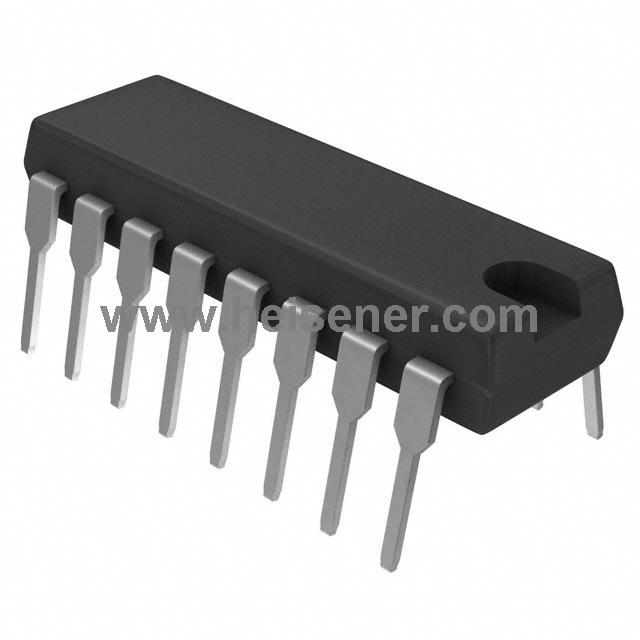
KA3525A Introduction
The KA3525A is a pulse width modulation (PWM) controller. It integrates all the necessary circuitry to control a switching power supply in a single package, including a voltage reference, error amplifier, oscillator, pulse width modulator, and output driver. The KA3525A operates at fixed frequency, set by an external resistor and capacitor, and it includes features such as adjustable dead time control, soft-start circuitry.
KA3525A Pinout

KA3525A CAD Model
Symbol

Footprint

3D Model

KA3525A Test Circuit

KA3525A Block Diagram

KA3525A Specifications
Here is a table listing the key specifications of the KA3525A PWM controller:
| Specification | Value |
| Voltage - Supply (Vcc/Vdd) | 7 V - 20 V |
| Output Voltage | 5.1V |
| Oscillator Frequency | Adjustable up to 500kHz |
| Output Current | 200mA (sink), 100mA (source) |
| Undervoltage Lockout | 8V (typical) |
| Duty Cycle (Max) | 49% |
| Dead Time Control | Programmable |
| Current Limit Threshold | Adjustable |
| Frequency - Switching | 60Hz - 430kHz |
| Operating Temperature | 0°C -70°C |
| Package | DIP-16, SOP-16 |
| Error Amplifier Gain | 90dB |
| Shutdown Current | 2mA (typical) |
| Typical Power Dissipation | 1000mW |
| Short Circuit Protection | Available |
| Sync Capability | Yes |
KA3525A Features
- Stable reference voltage of 5.1V ± 1%
- Source 100mA and sink 200mA
- The device includes an undervoltage lockout feature
- Soft start functionality and dead time control are programmable
- The current limit threshold is adjustable
- Supports an output duty cycle range from 0% to 100%
- The built-in error amplifier has a high gain of 90dB
- Features a low shutdown current of 2mA
- Short circuit protection
KA3525A Applications
Switching power supplies
DC-DC converters
Inverters
Battery chargers
Motor controllers
Uninterruptible power supplies (UPS)
Solar power inverters
Telecommunications power systems
Lighting systems
Industrial power controls
KA3525A Manufacturer
The KA3525A is manufactured by Onsemi, which provides high-performance, energy-efficient solutions for a range of applications, including automotive, communications, computing, consumer electronics, industrial, LED lighting, medical, and power supplies.
KA3525A Package
The KA3525A is available in a 16-DIP (Dual In-line Package) configuration. The 16-DIP package consists of 16 pins arranged in two parallel rows, each with 8 pins. This layout facilitates straightforward insertion into corresponding PCB holes.

KA3525A Equivalents
| Component | Manufacturer | Output Current | Input Voltage(Max) | Switching Frequency(Max) | Package Type |
| SG3525 | Texas Instruments | 500 mA | 35 V | 400 kHz | 16-DIP, 16-SOIC |
| TL494 | Texas Instruments | 250 mA | 40 V | 300 kHz | 16-DIP, 16-SOIC |
| UC3525 | Texas Instruments | 500 mA | 35 V | 400 kHz | 16-DIP, 20-SOIC |
| MC3525 | ON Semiconductor | 500 mA | 35 V | 400 kHz | 16-DIP, 16-SOIC |
| KA7500C | ON Semiconductor | 250 mA | 40 V | 200 kHz | 16-DIP, 16-SOIC |
How to Use KA3525A ?
To get started, connect the KA3525A in a standard application circuit. Begin by providing the power supply to the VCC pin (Pin 15). Connect a timing resistor and capacitor to the RT and CT pins (Pins 6 and 7) to set the oscillator frequency. The control voltage is applied to the inverting input of the error amplifier (Pin 2), while the non-inverting input (Pin 1) is typically connected to a reference voltage. The error amplifier compares the feedback voltage with the reference voltage and adjusts the output duty cycle accordingly. The outputs (Pins 11 and 14) are connected to the gates of external power transistors, which drive the load.
Then place a decoupling capacitor close to the VCC pin to filter out high-frequency noise. Additionally, protect the circuit from overcurrent conditions by connecting a current sense resistor and configuring the shutdown pin (Pin 10) to disable the output in the event of an overcurrent situation.
FAQs
What precautions should be taken when designing with the KA3525A?
Ensure proper decoupling of the power supply to minimize noise.
Carefully design the feedback loop for stability.
Use appropriate heat sinking for the power transistors to prevent overheating.
Implement overcurrent protection to safeguard the power supply.
What is the function of the error amplifier in the KA3525A?
The error amplifier compares the feedback voltage from the output with a reference voltage and adjusts the PWM duty cycle to maintain a constant output voltage.
How does the shutdown feature work?
The shutdown pin (Pin 10) can be used to disable the output drivers in case of a faulty condition such as overcurrent or overvoltage. When the voltage on this pin exceeds a certain threshold, the internal logic disables the output to protect the circuit.
What types of feedback loops are compatible with the KA3525A?
The KA3525A supports both voltage feedback and current feedback loops. Voltage feedback is typically used for output voltage regulation, while current feedback can provide additional control for current limiting and improved transient response.
How do I configure the dead-time control on the KA3525A?
The dead-time control is set using a resistor between the dead-time control pin (Pin 4) and the ground. This resistor determines the minimum time interval between the turning off of one transistor and the turning on of the next in push-pull configurations to prevent short circuits.